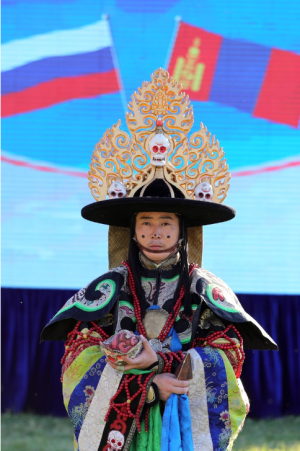November 5, 2021, marked the 100th anniversary of the establishment of diplomatic relations between Mongolia and the Russian Federation. In the span of a century, the two countries have shared more historical, political, and social commonalities than any of Mongolia’s other partners around the world, due to both geography and politically constructed alliances through different stages of governments. Withstanding the test of time, the history of Mongolia and Russia relations highlights extraordinary turning points in the history of Northeast Asia.
A century ago, on November 5, 1921, the Mongolian People’s Republic (MPR), and the USSR signed a Treaty of Friendship establishing diplomatic relations. A year later, in 1922, embassies were opened in Ulaanbaatar and Moscow. Despite this foreign policy accomplishment, the 1930-1940s were treacherous times where political and religious ideologies collided. Some 30,000-40,000 Buddhist monks, intellectuals, and noblemen were purged in Mongolia’s echo of the Stalinist purges underway in the Soviet Union. It wasn’t until 50 years later, in 1984 during the Tsedenbal-Batmunkh transition, that the two sides reconciled and put to rest these historical trials, with the push from the Mongolian side.
Even during the rocky period of the 1930s and ’40s, Mongolia and Russia — to be precise, the Russian Soviet Federative Socialist Republic — cooperated in a number of historical watershed moments.
One of the most recognized examples is the Battle of the Khalkhiin Gol, where the MPR and USSR armies fought the Imperial Army of Japan and the Japanese puppet-state of Manchukuo from May to September 1939. This series of Battle was a prelude to World War II, coming just before Germany’s invasion of Poland.
As most of Europe went to war with Nazi Germany, Russia, too, was drawn in. Mongolia’s supply of wool, warm clothing, food, and horses became a lifeline for the Russian soldiers fighting the Germans in the midst of winter. It is said that during Russia’s war against Germany, one in every five horses were Mongolian war horses. In 2015, the then president of Mongolia, Elbegdorj Tsakhia, gifted a large bronze horse statue, titled “Through the Warring Roads,” to the Russian people from the Mongolian people – a gentle reminder of Mongolia-Russia friendship, joint efforts, and a soft power move for its continued strong ties.
For 70 years, Mongolia’s domestic and foreign policies were heavily influenced by the Soviet Union, with its economic models inspired by socialism. There is no denying Russian influence in Mongolia. However, Mongolia’s strong relations with Russia were a major steppingstone for Mongolia to be recognized by the international community and gain foreign policy and diplomatic strength. At the same time, Russia’s industrial and economic development was mirrored in the development of Mongolia’s major sectors: infrastructure, energy, railroads, and major mining developments such as Erdenet. Even after the fall of the USSR, Mongolia continued to benefit from Russian investment. According to the Mongolian Foreign Ministry, “from 1990 to 2014, the volume of Russian investments in Mongolia reached 297 million USD, which accounts for 2.1% of total foreign direct investments in Mongolia.”
For the last five years, Mongolia has accelerated its foreign policy activities with its neighbors, including Russia, to embark on new opportunities that have the potential to diversify its mining-dependent economy. In 2019, during Russian President Vladimir Putin’s state visit to Mongolia, the two countries signed a Comprehensive Strategic Partnership Agreement, bringing Moscow and Ulaanbaatar even closer. The two countries are expanding cooperation in areas such as the economy, energy, and climate change-related issues.
In 2020, Russia ratified the Treaty on Friendly Relations and Comprehensive Strategic Partnership between Russia and Mongolia. On November 25 of this year, in commemoration of the 100th anniversary, Russian Foreign Minister Sergei Lavrov presented the Order of Friendship award to the Mongolian ambassador to Russia, Davaa Dulamsuren, recognizing his contribution and dedication in developing the Comprehensive Strategic Partnership between Mongolia and Russia.
Mongolia-Russia relations have also been expanding in the energy sector. As Russia supplies 92 percent of Mongolia’s energy demand, particularly fuel, this is a key sector for both countries. Beyond bilateral cooperation, however, the Power of Siberia 2 mega-project, which involves Russia, Mongolia, and China, could be a game-changer for Northeast Asian gas supply. The project, with the construction of “1,942 kilometers of gas trunklines with 114 wells,” would see Russian gas transit Mongolia en route to China. Via the Power of Siberia 2 pipeline, Russia’s energy pivot to Asia includes Mongolia. The government of Mongolia has been proactive in pursuing the pipeline as well, sealing a Memorandum of Understanding (MOU) with Russia in 2019.
In commemoration of the 100th anniversary of Mongolia-Russia ties, the Foreign Ministry of Mongolia organized a scholarly conference on “Mongolia-Russia Relations: Past, Present, and Future.” Deputy Foreign Minister B. Munkhjin, Member of Parliament S. Odontuya, and S.A. Kramintsyev, an adviser to the Russian Embassy in Mongolia, opened the conference. At the conference, historians and scholars emphasized the fact that Mongolia and Russia and their peoples have worked together to overcome challenges and political transformations.
In addition, the Embassy of the Russian Federation in Mongolia and the Embassy of Mongolia in the Russian Federation organized 92 activities over the course of a month-long celebration of the two countries’ century-long ties.
Moreover, the Office of the President, the parliamentary group on Mongolia-Russia relations, and the Foreign Ministry of Mongolia organized a historic photo gallery, “Hundred Events of a Century” that featured rare black and white images of the 1921 People’s Revolution, the Battle of Khalkhiin Gol of 1939, and Russia’s involvement in World War II. These images captured many of the significant events that shaped Mongolia-Russia relations.
In his opening remarks, Russian Ambassador to Mongolia I. K. Azizov stated, “We hope that the photographs displayed in this exhibition will give a clear idea of the 100-year history of Mongolian-Russian relations and other events, and that allows us to see these events in the big picture.”

































